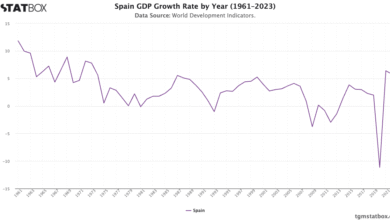US Inflation Rises 0.1% in May, Below Expectations

U.S. inflation has been a topic of intense scrutiny as it rose only 0.1% in May, falling short of expectations and influencing the inflation rate May 2025 to settle at 2.4%. This modest increase, highlighted by the consumer price index (CPI), underscores a complex interplay between rising consumer costs and stagnant wage growth. Excluding volatile food and energy sectors, the core CPI also mirrored minimal changes, suggesting that inflationary pressures may not be as dire as previously anticipated. A notable factor in this environment is the impact of energy prices, which have shown considerable weakness, helping to alleviate some inflation concerns. As stakeholders navigate these economic indicators, understanding the current trends is essential for predicting future developments in U.S. inflation.
The current state of inflation in the United States continues to capture attention as experts analyze its implications on the economy. Often referred to as price growth or consumer cost hikes, the inflation landscape features the consumer price index as a key metric for assessing changes in spending power. With energy prices causing significant fluctuations, it is crucial to observe their ongoing effects amidst broader economic developments. Furthermore, the core inflation rate provides a more stable view, excluding stark shifts in food and energy prices. As policymakers and economists focus on these trends, the conversation surrounding economic stability and consumer behavior intensifies.
Understanding U.S. Inflation Trends in May 2025
In May 2025, the U.S. inflation rate saw a modest increase of 0.1%, resulting in an annual inflation rate of 2.4%. This figure, reported by the Bureau of Labor Statistics, is lower than economists’ expectations of a 0.2% monthly increase. A critical component of this report is the Consumer Price Index (CPI), which reflects the prices of a wide range of consumer goods and services. As inflationary pressures remain steady, the core CPI, which excludes volatile items like food and energy, also indicated a minimal rise, thereby painting a comprehensive picture of consumer price stability amid external economic factors.
The modest inflation increase can be attributed to a combination of external and internal forces. Energy prices, for example, fell by 1% in May, which helped to stabilize the overall CPI increase. Additionally, tariff impacts anticipated on various consumer goods did not manifest in significant price hikes. Instead, prices for vehicles and apparel saw declines during this month, which indicates that the expected fallout from tariffs may not be immediately felt in consumer price indices.
Impact of Energy Prices on Inflation Rates
Energy prices have a profound influence on the inflation landscape, particularly in the calculation of the Consumer Price Index. In May 2025, energy costs slipped by 1%, contributing to a diminished overall inflation outlook. A substantial 2.6% decrease in gasoline prices substantiated this trend, marking a year-over-year decline of 12%. Such fluctuations in energy prices play a critical role in determining both the headline and core CPI, and their volatility can often overshadow other underlying inflation trends.
Despite the historical connection between rising energy prices and increased inflation, the recent data suggests a different narrative. As energy prices continue to stabilize, it mitigates the risk of abrupt spikes in the consumer price index. Analysts highlight that while energy costs influence short-term inflationary trends, the sustained decrease in these prices may lead to a less pressurized economic environment in the coming months. Therefore, the current energy price trajectory could be seen as a buffer against rising overall inflation, allowing consumers and policymakers to remain optimistic amid economic uncertainties.
Analyzing Core CPI and its Implications
Core CPI, which excludes food and energy prices, serves as a vital indicator for assessing long-term inflation trends. In May 2025, the core CPI saw an increase of 0.1%, resulting in an annual rate of 2.8%. This data is particularly important for the Federal Reserve, which relies on core measures to inform monetary policy decisions. By separating out the volatility of food and energy, core CPI offers a clearer view of inflation trends that may influence interest rate adjustments and overall economic strategy.
The Federal Reserve often regards core CPI as a more stable indicator of inflationary pressures. However, with a significant portion of the economy undergoing price adjustments due to tariffs, core inflation may reflect underlying pressures that could emerge later. Hence, while current core CPI readings seem manageable, analysts are cautious about potential future increases as tariff effects begin to ripple through the economy. Understanding these subtle shifts is key for economists and policymakers aiming to navigate the complexities of inflation.
Economic Repercussions of Tariffs on Consumers
The ongoing trade tensions and the implementation of tariffs have raised questions regarding their effects on consumer prices. In May 2025, initial reports suggested that President Trump’s tariffs were not yet significantly impacting inflation rates, with expectations for price adjustments still on the horizon. The modest increase in CPI corroborates this, indicating that many companies are utilizing existing inventories to navigate the current tariff landscape without raising prices excessively.
However, economists caution that as inventories dwindle and companies begin to pass on costs to consumers, we may see more pronounced price increases in the near future. The interconnectedness of global trade means that halted or increased costs from foreign producers could ultimately reshape consumer pricing mechanisms, leading to a potential spike in the Consumer Price Index. This situation demands attention, as fluctuating prices resulting from tariff policies could have far-reaching implications for consumer spending and economic stability.
Key Factors Behind the Consumer Price Index
The Consumer Price Index (CPI) is influenced by various components, including shelter, food, and apparel. In May 2025, the BLS noted that shelter costs were a primary driver of the 0.1% CPI rise, while food prices increased moderately by 0.3%. Interestingly, despite some fluctuations, overall food costs have remained relatively stable in the context of broader economic shifts, a point that underscores the resilience of certain sectors amid changing economic conditions.
While housing prices continue to exert upward pressure on inflation, other categories like apparel are witnessing declines. This dynamic indicates that inflation is not uniform across all categories, emphasizing how shifts in specific markets can alter overall consumer price perceptions. Hence, a comprehensive review of CPI components provides valuable insights into which sectors are experiencing inflationary pressures and which are buffered against change.
The Role of Real Wages in Inflation Analysis
Real wages are a crucial measure in inflation discussions, providing insight into consumers’ purchasing power amid rising prices. In May 2025, real average hourly earnings increased by 0.3%, showing a steady gain of 1.4% from the previous year. This increase in wages suggests that consumers are empowered to sustain their spending habits even as inflation ticked upward, indicating a balance in economic health despite rising costs.
Ultimately, understanding the relationship between real wages and inflation metrics can help clarify how consumers respond to rising prices. As workers experience growth in earnings, they may be more inclined to spend despite inflationary pressures, thereby bolstering economic growth and consumption. Such dynamics shape the business landscape, influencing how companies adjust their pricing strategies in light of wage-related consumer behavior.
Future Projections of Inflation Rates
As we look towards the future, inflation projections remain a critical concern for both policymakers and consumers. The recent CPI increase of 0.1% serves as an indicator of the current economic landscape, but the anticipated changes due to tariffs and external market pressures could lead to varying inflation rates. Economic analysts are cautious, projecting that inflation may climb if pricing adjustments begin manifesting in key sectors impacted by the recent trade disputes.
The careful monitoring of inflation data in the coming months will be essential for understanding the trajectory of the U.S. economy. While recent readings suggest a moderated inflation environment, changes in policy, such as adjustments in Fed interest rates, could significantly alter consumer spending patterns and economic activity. Therefore, stakeholders must remain vigilant as they navigate potential shifts in inflation dynamics.
The Bonds of Trade and Inflation Dynamics
Trade relationships play a pivotal role in shaping inflation dynamics, particularly in light of recent tariff implementations. The Trump administration’s imposition of tariffs aimed at balancing trade deficits has stirred widespread debate on its immediate and long-term impacts on consumer prices. For instance, analysts argue that while tariffs may not induce significant inflation initially, the cascading effects on supply chains and production costs could lead to an eventual uptick in the Consumer Price Index.
As negotiations continue with trade partners, the outcomes will be instrumental in determining inflation trajectories. A resolution that alleviates current trade tensions could stabilize prices and keep inflation rates in check, while prolonged disputes risk introducing heightened volatility across various consumer goods. Therefore, it is essential to assess how trade agreements could potentially curtail inflationary pressures in the broader economic context.
The Fed’s Interest Rate Considerations Amid Inflation Adjustments
In light of prevailing inflation metrics, the Federal Reserve faces complex considerations regarding interest rate movements. Currently, market expectations lean towards the Fed maintaining rates steady until at least September, with no immediate impetus to cut rates further despite relatively low inflation readings. Policymakers recognize that forthcoming inflation data will significantly influence their decision-making process, particularly as they assess the potential economic fallout from tariffs.
Moreover, the Fed’s stance on interest rates is closely tied to the ongoing evaluation of inflation trends, particularly core CPI measurements. The central bank aims to foster a balanced economic environment that accommodates growth while preventing runaway inflation. Thus, the interrelation between inflation statistics and interest rate strategies will remain a defining feature of monetary policy discussions in the months ahead.
Frequently Asked Questions
What was the inflation rate in the U.S. for May 2025?
The inflation rate in the U.S. for May 2025 was reported at 2.4%, reflecting a 0.1% increase from April. This measurement comes from the consumer price index (CPI), which tracks price changes across various goods and services.
How did energy prices impact the May 2025 inflation figures?
In May 2025, energy prices saw a decline of 1%, which contributed to tempering the overall increase in the consumer price index (CPI). This weakness in energy prices helped offset some of the inflationary pressures observed in other sectors.
What is core CPI and what did it indicate for May 2025?
Core CPI, which excludes food and energy prices, registered a 0.1% increase in May 2025, resulting in an annual rate of 2.8%. This figure is considered a better indicator of underlying inflation trends by Federal Reserve officials.
What factors contributed to the CPI increase in May 2025?
The CPI increase of 0.1% in May 2025 was primarily influenced by rising shelter costs, which the Bureau of Labor Statistics identified as a key factor. Additionally, a modest increase in food prices also contributed, while declines in energy prices and other goods, like apparel and vehicles, helped mitigate overall inflation.
How do tariffs relate to U.S. inflation rates as per the May 2025 report?
According to the May 2025 report, President Trump’s tariffs had not yet shown a significant impact on the inflation rate, as companies appeared to be using existing inventories or adjusting prices slowly due to uncertain demand. Economists noted that the effects of these tariffs might manifest later, potentially causing inflation to rise more noticeably.
What does the annual consumer price index (CPI) increase signify for consumers in 2025?
The annual CPI increase of 2.4% indicates that, on average, consumer prices have risen by this percentage over the year, suggesting that consumers may be facing higher costs for goods and services. This figure highlights trends in inflation that can affect purchasing power.
What are the implications of the CPI increase for monetary policy in the U.S.?
The modest CPI increase of 0.1% in May 2025 might lead policymakers to reassess interest rate strategies, with some calling for rate cuts amid easing inflation pressures. This scenario suggests a careful balance for the Federal Reserve as it evaluates the long-term impact of tariffs and overall economic conditions.
How do the recent inflation figures reflect on consumer purchasing power in the U.S.?
The latest inflation figures indicate that while there is a moderate rise in overall consumer prices, real average hourly earnings increased by 0.3%, suggesting some improvement in consumer purchasing power amidst rising costs, though mixed factors warrant caution.
| Key Points | |
|---|---|
| Consumer Price Index (CPI) Increase | 0.1% for May; Annual Inflation Rate at 2.4% |
| Core CPI Increase | 0.1% for May; Annual Rate at 2.8% |
| Energy Prices | Decreased by 1%; Gasoline dropped 2.6% |
| Food and Shelter Costs | Both up 0.3% in May; Shelter’s annual increase is lowest since late 2021 |
| Impact of Tariffs | Tariffs have not yet significantly affected prices; expectation of delayed impact |
| Market Reaction | Stock futures rose; Treasury yields decreased |
| Federal Reserve Outlook | Unlikely to lower rates until September |
| Data Collection Issues | BLS limited data collection due to staffing issues |
Summary
US inflation rose by only 0.1% in May, indicating a slower-than-expected growth in consumer prices. While annual inflation stands at 2.4%, concerns remain about the potential effects of tariffs. Energy prices have significantly underperformed, countering expected increases in other sectors. The stability of current inflation metrics suggests that the Federal Reserve may not be motivated to cut interest rates soon, even amid ongoing trade negotiations. Overall, the current landscape reveals a complex interaction of economic factors influencing inflation.



